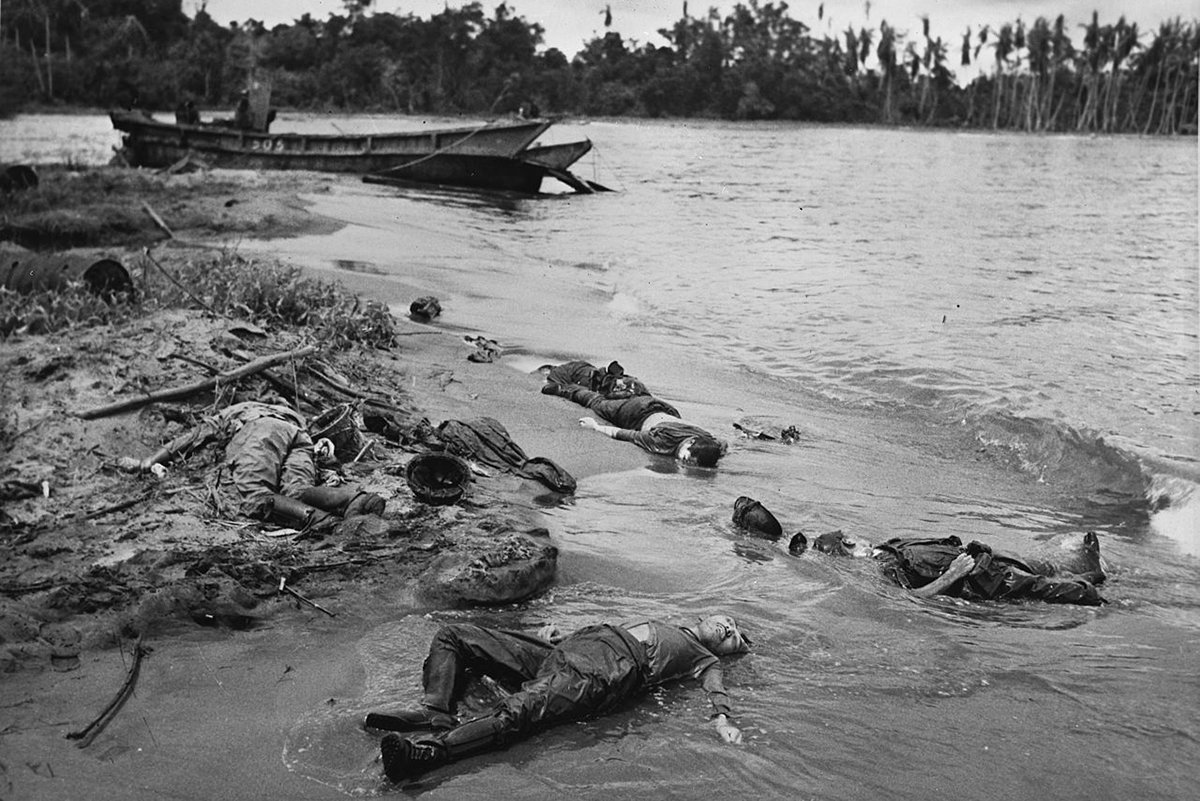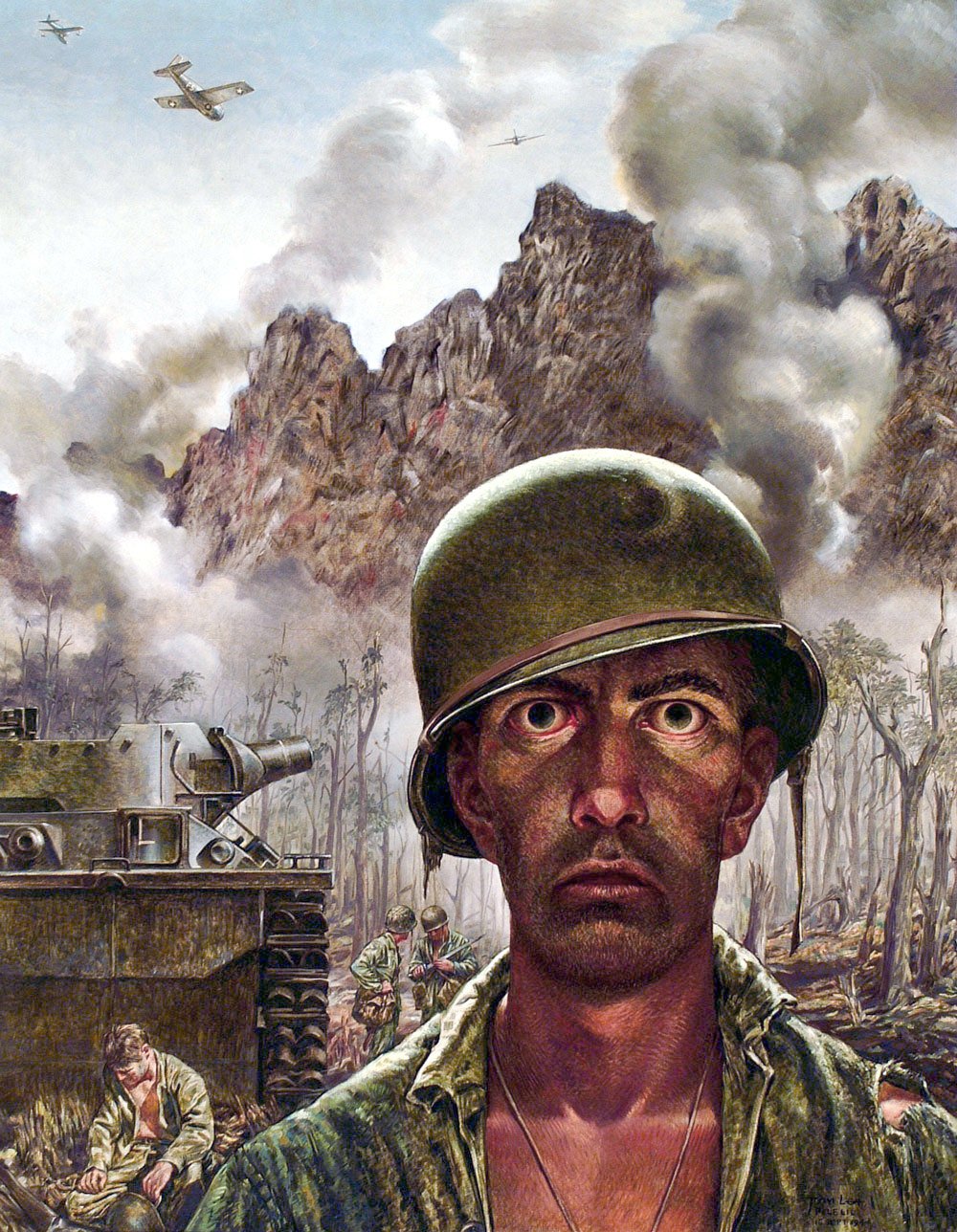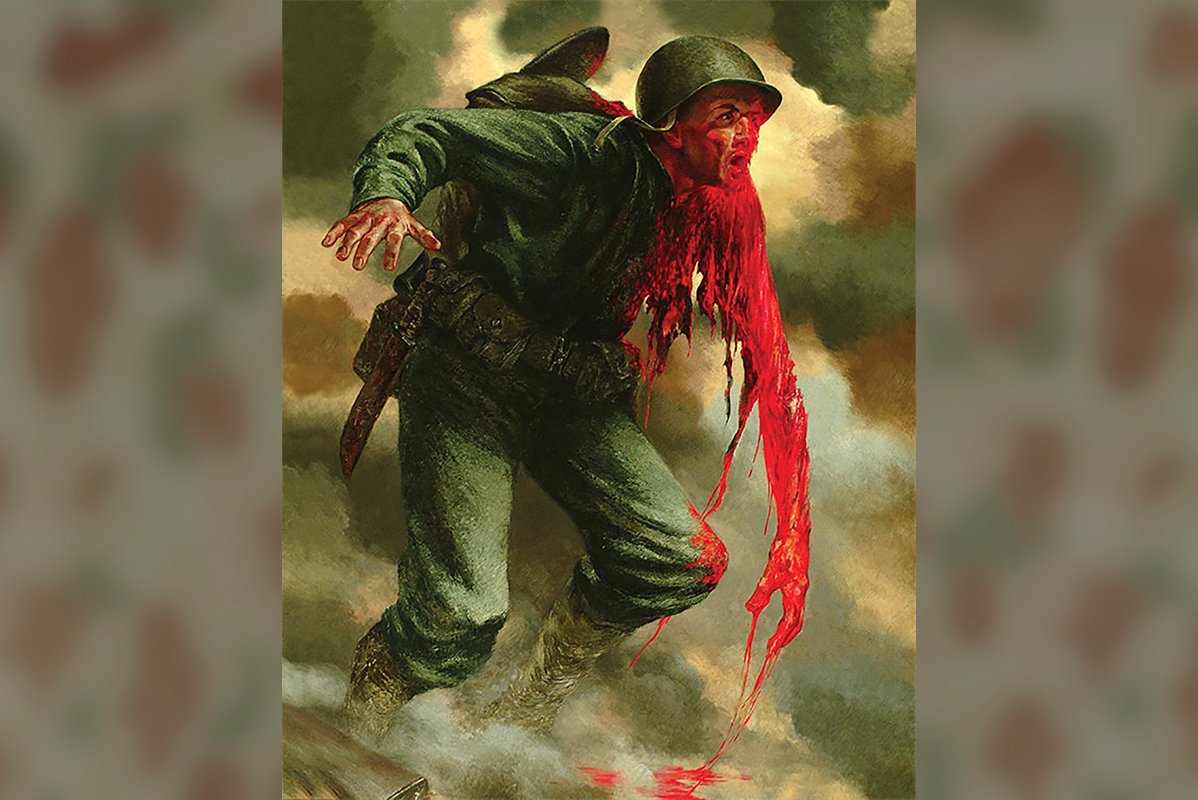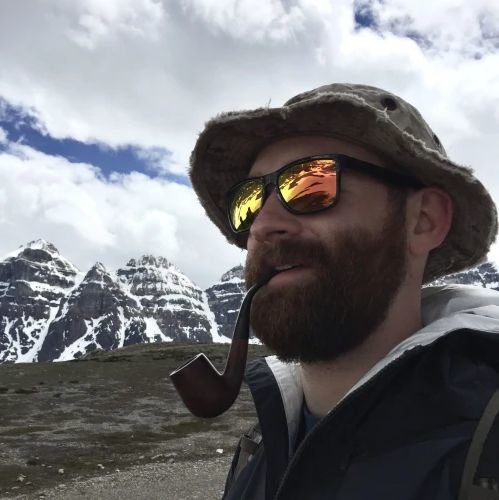When Truth Became a Casualty in World War II, Combat Artists Sought To Revive It

That 2,000 Yard Stare by Thomas Lea. Courtesy of Wikimedia Commons.
The nameless Marine stares blankly into the distance, his vacant eyes peeled inhumanly wide. According to the artist, he’s a combat veteran of both the enemy and tropical disease. Most of his unit has been destroyed in a battle history will deem unnecessary. He no longer sleeps soundly and is already preparing for the next attack. His face captures the psychological cost of war in a way photographs cannot.
The combination of photographic realism with the haunting expression speaks to a truth about the impact of sustained combat on the human psyche. Aptly titled Marines Call It That 2,000 Yard Stare, Thomas Lea’s painting of a man in the midst of the maelstrom on Peleliu popularized the term for the unfocused gaze service members often project when they go beyond the brink of combat-induced exhaustion.

Lea was among the proud cohort of combat artists who served in World War II — either as military members or as civilian correspondents. The artist from El Paso, Texas, got his start as a painter in 1920s Chicago, where he worked as a muralist. He held various positions throughout the United States until 1940, when he accepted a job for Life magazine as a war artist and correspondent.
In the early years of World War II, military officials censored any press photos showing America’s war dead. The policy sprang from the belief that Americans would be demoralized by photos showing the human cost of war. It wasn’t until editors at Life challenged the policy and fought to publish photographer George Strock’s now-iconic image of three American soldiers dead on a beach in New Guinea that images of service members killed in action could be printed. Life magazine published the photo in September 1943.
As David W. Dunlap wrote for the Lens blog of The New York Times, “the issue of printing Mr. Strock’s photo went all the way to President Franklin D. Roosevelt, who lifted the ban with the canny understanding that such graphic images might actually steel American resolve.”

Roosevelt allowed the image to be published because he believed doing so would help the American war effort, which relied heavily on selling war bonds to the public. In other words, images of dead soldiers could be published, but only in the interest of bolstering the American war machine.
Combat artists such as Lea, however, were under no such constraints, and so their works often captured the stark reality and horrors of war in a way that journalistic media of the time could not. Anyone who has practiced war correspondence should be familiar with the oft repeated adage, “Truth is the first casualty of war,” and in the context of World War II, the phrase speaks to the notion that an artist’s subjective interpretation of events may capture a sort of “higher truth” than photographic or journalistic renderings can.
“It is the intimate, personal, penetratingly perceptive touch, indeed, that is equipped to furnish a chapter that would have been missing were the camera exclusively relied upon,” The New York Times wrote in 1943 on the importance of combat artists.

While pro-war propaganda was hitting an all-time high in support of the massive war effort, media discourses on shell shock, battle fatigue, or combat stress reaction were rare. Amid that cultural backdrop, Lea joined the 1st Marine Division in 1944 to convey the experience of the bloody assault on the small Pacific island of Peleliu, where 1,656 Americans died.
Marine veteran Eugene Sledge famously documented the nightmarish details of the battle in his memoir With the Old Breed: At Peleliu and Okinawa, which is one of four books producers of HBO’s The Pacific optioned to make their acclaimed series.
“To the noncombatants and those on the periphery of action, the war meant only boredom or occasional excitement; but to those who entered the meat grinder itself, the war was a nether world of horror from which escape seemed less and less likely as casualties mounted and the fighting dragged on and on,” Sledge wrote in his memoir. “Time had no meaning; life had no meaning. The fierce struggle for survival in the abyss of Peleliu had eroded the veneer of civilization and made savages of us all.”

It took Sledge 37 years to publish what most consider his magnum opus and one of the greatest war memoirs ever penned. Lea, on the other hand, completed Marines Call It That Two Thousand Yard Stare in 1944, conveying to the American public the devastating impact that prolonged exposure to heavy combat can have on the human psyche.
The soldier’s eyes in Lea’s eerie painting pull the viewer into the depths of the apparent devastation wrought on the soldier’s soul. The effect is similar to Ray Platnick’s photo of a Marine following two days of heavy fighting on Eniwetok: another of the many battles fought in the costly island-hopping campaign during WWII. But Platnick’s image wasn’t widely circulated until after the war. The same can be said of video revealing Peleliu veterans in the throes of combat-induced mental exhaustion.
The paintings and drawings produced by combat artists were often the only vehicle by which Americans could view a more accurate rendering of the war and service members’ reactions to it. When Life magazine’s editors published Strock’s now-famous photo of dead American service members, they captioned the image with this rationalization:
“Why print this picture, anyway, of three American boys dead upon an alien shore? Is it to hurt people? To be morbid? Those are not the reasons. The reason is that words are never enough. The eye sees. The mind knows. The heart feels. But the words do not exist to make us see, or know, or feel what it is like, what actually happens. The words are never right.”
But the image that’s often championed as a victory for the cause of truth in American media shows three expired but intact bodies whose faces are obscured. Americans were allowed to look at the image because the president believed the photograph — somber yet still modest in its lack of gore — would bolster support for the war.

By putting the maiming of the human form front and center, Lea’s oil painting The Price provides a powerful counterpoint to the vast majority of carefully curated photos and videos distributed to the American public during the war. The piece depicts a mortally wounded Marine whose mangled arm dangles ghoulishly in crimson ribbons by his side. The bright red contrasted with the Marine’s green uniform reveals a shocking level of violence that, although common on battlefields, was largely omitted from photographs and videos of combat during WWII.
At a time when journalism and media were key fixtures in a war against global tyranny, American artists went to war so they could render the experience with a level of depth and complexity that only their unique mediums were equipped to communicate.
Read Next: WATCH: The Bloody Documentary That Won the Marine Corps an Oscar

Mac Caltrider is a senior staff writer for Coffee or Die Magazine. He served in the US Marine Corps and is a former police officer. Caltrider earned his bachelor’s degree in history and now reads anything he can get his hands on. He is also the creator of Pipes & Pages, a site intended to increase readership among enlisted troops. Caltrider spends most of his time reading, writing, and waging a one-man war against premature hair loss.
BRCC and Bad Moon Print Press team up for an exclusive, limited-edition T-shirt design!
BRCC partners with Team Room Design for an exclusive T-shirt release!
Thirty Seconds Out has partnered with BRCC for an exclusive shirt design invoking the God of Winter.
Lucas O'Hara of Grizzly Forge has teamed up with BRCC for a badass, exclusive Shirt Club T-shirt design featuring his most popular knife and tiomahawk.
Coffee or Die sits down with one of the graphic designers behind Black Rifle Coffee's signature look and vibe.
Biden will award the Medal of Honor to a Vietnam War Army helicopter pilot who risked his life to save a reconnaissance team from almost certain death.
Ever wonder how much Jack Mandaville would f*ck sh*t up if he went back in time? The American Revolution didn't even see him coming.
A nearly 200-year-old West Point time capsule that at first appeared to yield little more than dust contains hidden treasure, the US Military Academy said.












